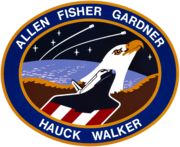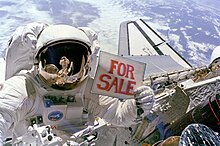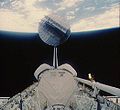STS-51-A
This article includes a list of references, related reading, or external links, but its sources remain unclear because it lacks inline citations. (May 2008) |
| COSPAR ID | 1984-113A |
|---|---|
| SATCAT no. | 15382 |
| End of mission | |

 | |
STS-51-A was the second flight of Space Shuttle Discovery, and the fourteenth shuttle flight. It conducted the third landing at Kennedy Space Center.
STS-51-A mission was unique in that it marked the first time the shuttle had deployed two communications satellites, and retrieved from orbit two other communications satellites. Palapa B-2 and Westar 6 had been deployed during the STS-41-B mission earlier in the year, and had been placed into improper orbits because their kick motors malfunctioned.
Crew
Number in parentheses indicates number of spaceflights by each individual prior to and including this mission.
- Frederick Hauck (2) - Commander
- David M. Walker (1) - Pilot
- Anna Fisher (1) - Mission Specialist
- Dale Gardner (2) - Mission Specialist
- Joseph P. Allen (2) - Mission Specialist
Mission parameters
- Mass:
- Orbiter liftoff: 119,441 kg
- Orbiter landing: 94,120 kg
- Payload: 20,550 kg
- Perigee: 289 km
- Apogee: 297 km
- Inclination: 28.4°
- Period: 90.4 min
Space walks
- Allen and Gardner - EVA 1
- EVA 1 Start: November 12, 1984 - 13:25 UTC
- EVA 1 End: November 12, - 19:25 UTC
- Duration: 6 hours, 00 minutes
- Allen and Gardner - EVA 2
- EVA 2 Start: November 14, 1984 - 11:09 UTC
- EVA 2 End: November 14, 1984 - 16:51 UTC
- Duration: 5 hours, 42 minutes
Mission highlights

Less than a month after the 41-G flight, the 14th space shuttle mission and the second for Discovery, STS 51-A was launched at 7:15 a.m. EST, Nov. 8, 1984. A launch attempt the day before was scrubbed at the T minus 20-minute built-in hold because of high shear winds in the upper atmosphere.
The five-person flight crew consisted of Frederick H. Hauck, commander, on his second flight; pilot David M. Walker; and three mission specialists -- Anna L. Fisher, Dale A. Gardner and Joseph P. Allen. Both Gardner and Allen were making their second shuttle flights.
The two communications satellites successfully deployed were the Canadian Anik D2 -- on the second day of the mission -- and SYNCOM IV-l, also known as Leasat l, on the third day.
The orbiter then began a series of maneuvers to meet up with the first of the two satellites to be recovered, Palapa B-2. (The orbits of both satellites had been lowered by ground commands from about 600 mile to 210 mile to facilitate recovery operations.) On day five, Discovery rendezvoused with PALAPA. Mission specialists Allen and Gardner performed an EVA, capturing the satellite with a device known as a "Stinger," which was inserted into the apogee motor nozzle by Allen. The satellite's rotation was slowed to 1 RPM and Fisher, operating from a position on the end of the RMS, attempted unsuccessfully to grapple the satellite. Allen was able manually to maneuver the satellite into its cradle with Gardner's help and aided by the RMS which was operated by Fisher. The successful, improvised rescue effort took two hours.
The recovery of Westar 6 was not as difficult and took place a day later. This time Gardner, using the same muscle power technique Allen had used for the rescue, captured the satellite. With Allen's help, he placed it in a cradle in the cargo bay.
The STS 51-A mission also carried the Diffused Mixing of Organic Solutions (DMOS) experiment. It was the first of a series of comprehensive organic and polymer science experiments sponsored by the 3M Corp. This middeck experiment was successful and the proprietary results of the chemical mixes were turned over to 3M. One other experiment, the radiation monitoring experiment, was also performed.
The satellite recoveries on this mission were the last untethered spacewalks until 1994 and the last use of the Manned Maneuvering Unit. During 1994, the SAFER was tested on STS-64. All subsequent spacewalks by NASA and the Soviets/Russians have had the astronauts tethered to the craft by some means.
This second Discovery mission ended at 7 a.m. EST on November 16 with landing on Runway 15 at KSC. The flight completed 126 orbits and lasted 7-day, 23-hour and 45-minutes. The uncredited landing of STS 51-A is recorded at the beginning of the IMAX documentary The Dream is Alive. It was the third shuttle landing at KSC and the fifth and last shuttle mission of 1984.
Gallery
-
Syncom IV-1 after deployment
-
Gardner retrieves Westar 6
-
Palapa B-2 is loaded into the payload bay
See also
- Space science
- Space shuttle
- List of space shuttle missions
- List of human spaceflights chronologically




